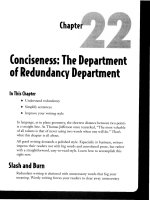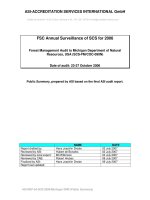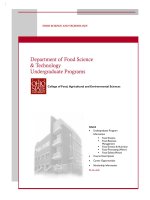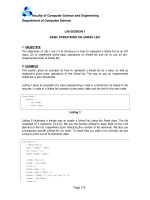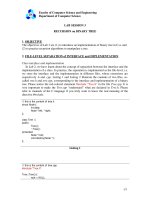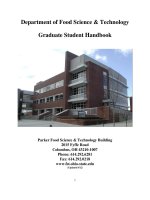DEPARTMENT OF NATURAL SCIENCE SUBJECT: CHEMISTRY
Bạn đang xem bản rút gọn của tài liệu. Xem và tải ngay bản đầy đủ của tài liệu tại đây (364.36 KB, 11 trang )
DUY TAN UNIVERSITY
DEPARTMENT OF NATURAL SCIENCE
SUBJECT: CHEMISTRY
CHEMISTRY
RATE OF A CHEMICAL REACTION
2015
Reaction rate
1. Definition
The rate of a chemical reaction is a measure of how fast the
reaction occurs.
2015
Reaction rate
The rate of a chemical reaction is measured as a change in the
amounts of reactants or products divided by the change in time.
Generic reaction:
aA + bB → cC + dD
1 ∆ A
1 ∆ B 1 ∆ C 1 ∆ D
Rate = −
=−
=
=
a ∆t
b ∆t
c ∆t
d ∆t
2015
Reaction rate
Exercise 1
The equation for a reaction is:
2NO2(g) + H2O(g) + 1/2O2(g) → 2HNO3 (g)
Which one of the following is not numerically equal to the others?
1 ∆ [ NO2 ]
A. − .
2
∆t
∆ [ H 2O ]
C. −
∆t
1 ∆ [ O2 ]
B. − .
2 ∆t
1 ∆ [ HNO3 ]
D.
2
∆t
Answer: B
Reaction rate
For example
Consider the following balanced chemical equation
+
H2O2 (aq) + 3I (aq) + 2H (aq) → I3 (aq) + 2H2O(l)
In the first 10,0 second of the reaction, the concentration of I
-
from 1.000M to 0,868M.
Calculate the average of the reaction rate in this time interval.
2013
dropped
2. The rate Law:
The effect of concentration
Consider this reaction:
aA + bB → cC + dD
m
n
Rate = k[A] . [B]
k: rate constant
m: the reaction order with respect to A
n: the reaction order with respect to B
m + n: the overall order
The rate law for any reaction must always be determined by experiment.
2. The rate Law:
The effect of concentration
For example:
2NO2(k) + F2(k) → 2NO2F(k)
Rate = k[NO2][F2]
2. The rate Law:
The effect of concentration
EXAMPLE
Consider the reaction and the obtained rate / concentration data:
A(aq) + B(aq) → C(aq)
[A]
[B]
rate
1
0.10
0.10
3.10
2
0.10
0.20
6.10
3
0.20
0.10
-2
1.2 .10
-3
-3
3. The Effect of Temperature on Reaction Rate
The Arhenius equation
− Ea
k = A.e RT
R: the gas constant (8.314 J/mol.K)
A: constant called the frequency factor
Ea : the activation energy (is an energy barrier or hump that must be
surmounted for the reactants to be transformed into products)
Thank you
